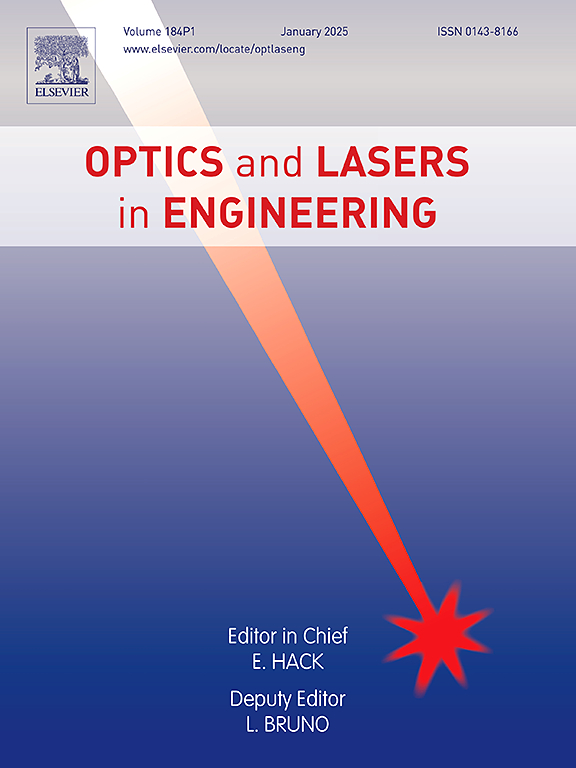Machine learning assisted distributed low pressure measurement based on optical carrier-based microwave interferometry
IF 3.5
2区 工程技术
Q2 OPTICS
引用次数: 0
Abstract
The distributed measurement of low pressure utilizing common optical fibers without sensitization is desired but challenging in many industrial applications. In this paper, with the assistance of machine learning, the distributed measurement of low hydrostatic pressure is realized based on optical carrier-based microwave interferometry (OCMI) employing the common single-mode fiber (SMF). Firstly, the theoretical model of pressure sensitivity is established, and further investigated and validated by numerical simulation and finite element simulation. Subsequently, a distributed hydrostatic pressure measurement experiment is conducted utilizing a common SMF with cascaded weak light reflectors processed along the fiber core. The results indicate that it is difficult to measure low pressure through common fibers based on the traditional demodulation method. To overcome the above limitations, we propose to employ machine learning to analyze the microwave interference information, in order to achieve a one-to-one mapping with the hydrostatic pressure exerted on the sensing fiber. The implementation of distributed pressure measurement is based on the unique advantages of OCMI in terms of physical positioning and reconfigurable gauge length. Meanwhile, different microwave interferometric information is employed as inputs for comparison to select the most effective signals for optimal prediction. The results show that a satisfactory overall measurement and distributed measurement of low hydrostatic pressure can be achieved with the assistance of machine learning, where the accuracy of distributed measurement increases with the increase of Fabry-Perot interferometer (FPI) cavity length. The proposed strategy can be extended to other relatively short-distance spatially continuous distributed or long-distance quasi-distributed fiber sensing systems.
基于光载波微波干涉测量法的机器学习辅助分布式低压测量技术
在许多工业应用中,利用普通光纤进行无敏化低压分布式测量是人们所期望的,但也是具有挑战性的。本文在机器学习的帮助下,利用普通单模光纤(SMF),基于光载波微波干涉仪(OCMI)实现了低静压的分布式测量。首先,建立了压力灵敏度的理论模型,并通过数值模拟和有限元模拟进行了进一步研究和验证。随后,利用沿纤芯处理级联弱光反射器的普通 SMF 进行了分布式静水压力测量实验。结果表明,传统的解调方法很难通过普通光纤测量低压。为了克服上述局限性,我们建议采用机器学习来分析微波干扰信息,从而实现与施加在传感光纤上的静水压力的一一对应。分布式压力测量的实现基于 OCMI 在物理定位和可重新配置测量长度方面的独特优势。同时,采用不同的微波干涉测量信息作为输入进行比较,以选择最有效的信号进行优化预测。结果表明,在机器学习的帮助下,可以实现令人满意的低静水压整体测量和分布式测量,其中分布式测量的精度随着法布里-珀罗干涉仪(FPI)腔长的增加而提高。所提出的策略可扩展到其他相对短距离的空间连续分布式或长距离准分布式光纤传感系统。
本文章由计算机程序翻译,如有差异,请以英文原文为准。
求助全文
约1分钟内获得全文
求助全文
来源期刊

Optics and Lasers in Engineering
工程技术-光学
CiteScore
8.90
自引率
8.70%
发文量
384
审稿时长
42 days
期刊介绍:
Optics and Lasers in Engineering aims at providing an international forum for the interchange of information on the development of optical techniques and laser technology in engineering. Emphasis is placed on contributions targeted at the practical use of methods and devices, the development and enhancement of solutions and new theoretical concepts for experimental methods.
Optics and Lasers in Engineering reflects the main areas in which optical methods are being used and developed for an engineering environment. Manuscripts should offer clear evidence of novelty and significance. Papers focusing on parameter optimization or computational issues are not suitable. Similarly, papers focussed on an application rather than the optical method fall outside the journal''s scope. The scope of the journal is defined to include the following:
-Optical Metrology-
Optical Methods for 3D visualization and virtual engineering-
Optical Techniques for Microsystems-
Imaging, Microscopy and Adaptive Optics-
Computational Imaging-
Laser methods in manufacturing-
Integrated optical and photonic sensors-
Optics and Photonics in Life Science-
Hyperspectral and spectroscopic methods-
Infrared and Terahertz techniques
 求助内容:
求助内容: 应助结果提醒方式:
应助结果提醒方式:


